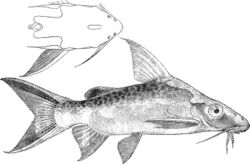Biology:Synodontis pleurops
| Synodontis pleurops | |
|---|---|

| |
| Scientific classification | |
| Domain: | Eukaryota |
| Kingdom: | Animalia |
| Phylum: | Chordata |
| Class: | Actinopterygii |
| Order: | Siluriformes |
| Family: | Mochokidae |
| Genus: | Synodontis |
| Species: | S. pleurops
|
| Binomial name | |
| Synodontis pleurops Boulenger, 1897
| |
Synodontis pleurops, known as the Congo squeaker,[2] the bigeye squeaker,[2] or the bug eyed synodontis,[3][4] is a species of upside-down catfish native to the upper Congo Basin of Cameroon, the Democratic Republic of the Congo and the Republic of the Congo.[2] It was first described by the Belgian-British zoologist George Albert Boulenger in 1899, based upon a holotype discovered at the Boyoma Falls, in the Democratic Republic of the Congo.[3]
Description
The body of the fish is brown and mottled, with brown edges on the caudal fin lobes.[4] It is whitish on the underside.[5] The species is noted for its large head and eyes.[3][4] As individuals age the colors tend to fade somewhat.[4]
Like other members of the genus, this fish has a humeral process, which is a bony spike that is attached to a hardened head cap on the fish and can be seen extending beyond the gill opening.[3] The first ray of the dorsal fin and the pectoral fins have a hardened first ray which is smooth in the front and serrated on the back, a little shorter than the head.[5] The caudal fin is deeply forked.[5] It has short, cone-shaped teeth in the upper jaw.[3] In the lower jaw, the teeth are s-shaped and movable.[3] The fish has one pair of long maxillary barbels, extending far beyond the operculum, and two pairs of mandibular barbels that are often branched.[3][4] The adipose fin is small, 2 to 3 times as long as deep.[5] The anal fin is pointed.[5]
This species grows to a length of 23 centimetres (9.1 in) SL although specimens up to 32.5 centimetres (12.8 in) TL have been recorded in the wild.[2][3]
Habitat
In the wild, the species inhabits tropical waters with a temperature range of 22 to 26 °C (72 to 79 °F), a pH of 6.0 – 7.0, and dH range of up to 10.[2] It has been found throughout the Congo River basin, with the exception of the Luapula River system.[6]
References
- ↑ Moelants, T. (2010). "Synodontis pleurops". IUCN Red List of Threatened Species 2010: e.T182894A7996626. doi:10.2305/IUCN.UK.2010-3.RLTS.T182894A7996626.en. https://www.iucnredlist.org/species/182894/7996626. Retrieved 12 November 2021.
- ↑ 2.0 2.1 2.2 2.3 2.4 Froese, Rainer and Pauly, Daniel, eds. (2016). "Synodontis pleurops" in FishBase. June 2016 version.
- ↑ 3.0 3.1 3.2 3.3 3.4 3.5 3.6 3.7 "Synodontis pleurops Boulenger, 1897". Planet Catfish. 19 Jul 2013. http://www.planetcatfish.com/common/species.php?species_id=56.
- ↑ 4.0 4.1 4.2 4.3 4.4 "Synodontis pleurops Boulenger, 1897". scotcat.com. http://www.scotcat.com/mochokidae/s_pleurops.htm.
- ↑ 5.0 5.1 5.2 5.3 5.4 Boulenger, George Albert (1909). Catalogue of the fresh-water fishes of Africa in the British museum (Natural history). London: British Museum. pp. 466–468. https://archive.org/stream/cu31924024781837/#page/n484/mode/1up.
- ↑ Moelants, T. (2010). "Synodontis notatus". IUCN Red List of Threatened Species 2010. https://www.iucnredlist.org/details/182894/0. Retrieved 17 October 2016.
External links
Wikidata ☰ Q920484 entry
 |


